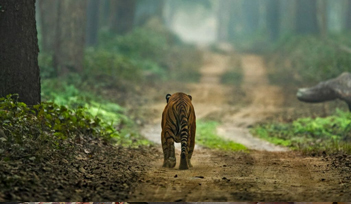Home > Deers of Dudhwa National Park
Deers of Dudhwa National Park
Nature has endowed India with a magnificent asset of flora and fauna. There arc more than 500 different species of mammals found within the Indian region.
They include the Elephant, the Gaur, the Great Indian Rhinoceros, the gigantic wild sheep of the Himalayas, the Swamp deer, the Spotted deer, one of the most beautiful of all deer, the Fourhorned Anti lope, and the Black buck the only representative of its genera. The beasts of prey include the Lion and the Tiger, the most magnificent of all the great cats and such splendid creatures as Leopard. Other species like Fox, Jackal, Hyaena, Wolf, Hares, Civets, Marmots, Squirrels, Langur, Macaque, bear, bat etc.There is always an attraction and chat in which the presence of wildlife gives to our jungles.
Apart from many mammals Dudhwa National Park has five species of deer. Deer are diffemt from anti lope. An antilope horns are permanent and without branches; deer on the other hand shed and regrow their antlers periodically and have branched antlers. A young deer's antler is a simple spike. With the growth of the animal, in the process of periodic renewal, it throws out tines or branches and eventually takes the familiar form of an antler. The newly-grown antler is encased in a thick soft skin called 'Velvet'. Its softness and its dense covering mat of fine hairs give it the feel and the look of velvet. This skin, fed by numerous blood vessels, is highly sensitive and easily injured. When their horns are growing, deer which live habitually in dense forests take great care to avoid any harm coming to them. While their antlers are in velvet, deer naturally do not use them in attack or defence.
Stags wear their antlers for period after the rut and then shed them. The time of shedding varies with age. Young stags shed them earlier than the older animals. The time of shedding may also vary with locality. Among other factors, it is said that good feeding conditions influence early shedding. This suggests some connection between food and horn-growth. The period of horn-growth everywhere coincides with the season when food is most abundant. The food itself consists mainly of grass, and grass contains abundance of calcium which enters largely into the making of bone. During mating season stag fights stag for the possession of the hinds. Antlers again are a means of defence against carnivorous enemies and certainly provide some protection. Acute scent, hearing, and sight and speed of movement are the deer's essential means of escape.
Seasonal changes in the colour of the coat are marked in most deer. They exchange a light-toned summer coat for a darker winter dress.The darker coat harmonises with subdued light in forest and grass jungle, obscured during the cold weather by a luxuriant post-monsoon vegetation. The lighter summer coat is in keeping with the excessive light of the hot weather, when forests and grass jungles are dry. Summer coats are usually spotted in young stags of Swamp deer and Hog deer. A dappled coat is proably protective and makes for better concealment.
The role of runinants in the scheme of nature is a cheek on the exuberant growth of grass and other herbage. Each species plays its role in its special niche, Sambar in forest, Chital on its fringes, Swamp deer in marsh or grass plains, Barking deer in undulating land of forest and Hog deer in well developed grassland. In common with other ruminants deer provide a basic food for a long range of carnivores.
Means of communication
Deer have various ways of communicating with one another. All species of deer have alarm calls, sharp staccato barks, whistles, etc. which they utter when suspicious and continue to repeat until reassured. Yet another way of attaracting attention is stamping with the feet. With some species this drumming with the feet is the preliminary to the alarm call. Roar or bellow of the stags before or during the mating time are quite different. The call is described as the embodiment of lust, a vent to anger and jealousy. A challenge to rivals, it is one of the most thrilling and awe-inspiring sounds of the forest. Communication between mother and young is effected by low murmuring calls and also by stamping of feet.
Social life
Most of the larger deer are gregarious. Newly matured stags show a tendency to group together. Sometimes an old stag is accompanied by one or two younger animals which act as sentinels, or old stags may become entirely anti-social and live either alone or with a companion of similar morose inclinations. Hinds live in family groups. The young remain with the mother till they attain maturity, which is not till they are three years old. The young follow the leadership of the parent hind. Even when several family groups assemble to form a single unit, leadership is assumed by one of the leader hinds and her supremacy is never challenged.
Swamp deer or Barasingha (Cervus duvauceli duvauceli)
This splendid deer lives on marshland and is state animal of Uttar Pradesh. A stag stands 135 cm. at the shoulder and scales 170 to 180 kg. Average horns measure 75 cm. round the curve. The colour of coat, almost woolly in texture, shades from brown to yellowish brown. The stags are maned and darker in colour. The summer coat of stags and hinds is paler, some develop spots, not always distinct, of lighter tone. The young are spotted.
There is much variation in the form of antlers. 10 to 14 is the usual number of points. Swamp deer are highly gregarious. They are less nocturnal than Sambar. Their eyesight and hearing are moderate, the sense of smell acute. When alarmed the whole herd sets up a shrill baying sound which is continued in flight. They live more or less in amity till the rut develops.
This deer species belongs to the Schedule I of Wildlife Protection Act' 1972. This is one of the flagship species of Dudhwa Tiger Reserve.This reserve boasts the presence of one of the maximum populataion of swamp deer in entire Asia.
Jhaadi Tall in Kishanpur Wildlife Sanctuary part of DTR enjoys world's largest congregation of this species. At times, the number goes beyond 800 in a single herd.
Sambar (Cervus unicolor)
The Sambar is the largest Indian deer and carries the grandest horns: height at shoulder nearly 150 cm., a full grown stag scales from 225 to 320 kg. A Sainbar head can be upto 95 cm.
The coat is coarse and shaggy. In stags it forms a mane around the neck and throat. The colour of coat is brown with a yellowish or greyish tinge. The underparts are paler. Females are lighter in tone. Old stags tend to become very dark. The antlers are stout and rugged. The full number of points (six) are developed in the fourth year.
Forested hill-side, preferably near cultivation, are the favourite haunt of the Sambar. Their food consists of grass, leaves and various kinds of wild fruit. They feed mainly at night and retire into heavy cover at daybreak. Their power of sight is moderate, scent and hearing acute. Pairing takes place in November and December. The stag's harem is limited to a few hinds. After the rut he deserts them and lives a solitary life till the return of the mating season. The young are born at the commmencement of the rains, in late May or early June. Young stags remain with the hinds. Sambar are rarely found associating in large number.
Spotted deer or Cheetal (Axis axis)
The Cheetal is perhaps the most beautiful of all deer. Its coat is a bright rufous-fawn profusely spotted with white at all ages and in all seasons. Old bucks are more brownish in colour and darker. The graceful antlers have six tines. The Spotted deer stag stands 90 cm. at the shoulder and weighs about 85 kg.
Cheetal are found wherever there is jungle combined with good grazing and a plentiful supply of water. They are seen in herds of ten to thirty, which may contain two or three stags. The rutting stag has a loud harsh bellow and combats between the males for the possession of the hinds are fierce and frequent. The pairing takes place during the winter months. Fawns may be met with at any season. Usually the mother gives birth to a single fawn. Cheetal are prolific breeder; an interval of six months may see the production of a new family.
Hog-deer (Axis porcinus)
The name Hog-deer has probably been suggested by the squat pig-like appearance of this animal and by its hog-like movements. When running it keeps its head low down. The height at the shoulder is 60 cm., average horns measure 30 to 38 cm. The hog-deer is smaller and stouter in build. The body is long and the legs relatively short. The fur is brown, dark brown in old stags with a yellowish or reddish tinge. The underparts of the body are paler and inside of the ears and the underside of the tail are white. The young are spotted.
The small antlers are set upon very long bony pedicels. After giving out a short brow tine the beam is almost straight till it devides into a longer fore and shorter hind tine.
This deer favour grass jungles by the banks of rivers, grass-covered delta islands or open grass plains; always where the grass is not too high. They may be seen grazing together in small parties up to 20 in number. Their sense of sight, smell and hearing is acute. Pairing season is September and October and the young are dropped inApril and May.
Barking deer or Muntjae (Muntiacus inuntjak)
The coat of Barking deer is bright chestnut. They are seen single or in pairs or in small family parties. Muntjac keep to more or less thick jungle and come out to graze in the outskirts of forest or in open clearings. They are fairly diurnal in habit. The food consits of various leaves and grasses and wild fruits. The call from distance sounds much like the bark of a dog.
Height at the shoulder of an adult male is from 50 to 75 cm.; its weight is about 22 kg. The antlers are small, consisting of a short brow-tine and an unbranched beam. They are set on bony hair covered pedicels which extend down each side of the face as bony ridges. In some tufts of bristly hair replace the horns. Old males are browner in colour. The upper canines of the male are well developed and are used by the animal in self defence.
When alarmed and in flight 'hese deer give out a series of short cackling barks. Muntjac appear to breed at all seasons.The rut mainly takes place in the cold weather. The young, usually one, sometimes two, are born at the beginning of the rains.









